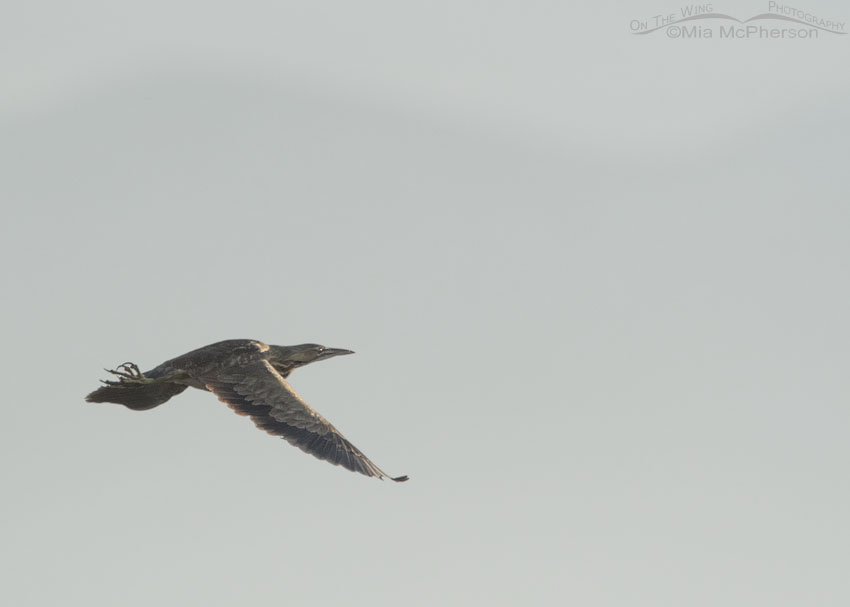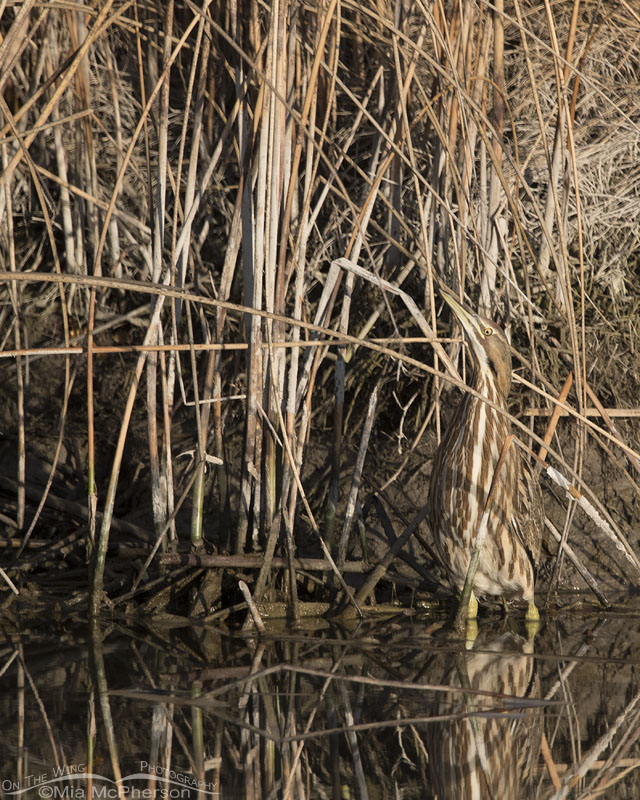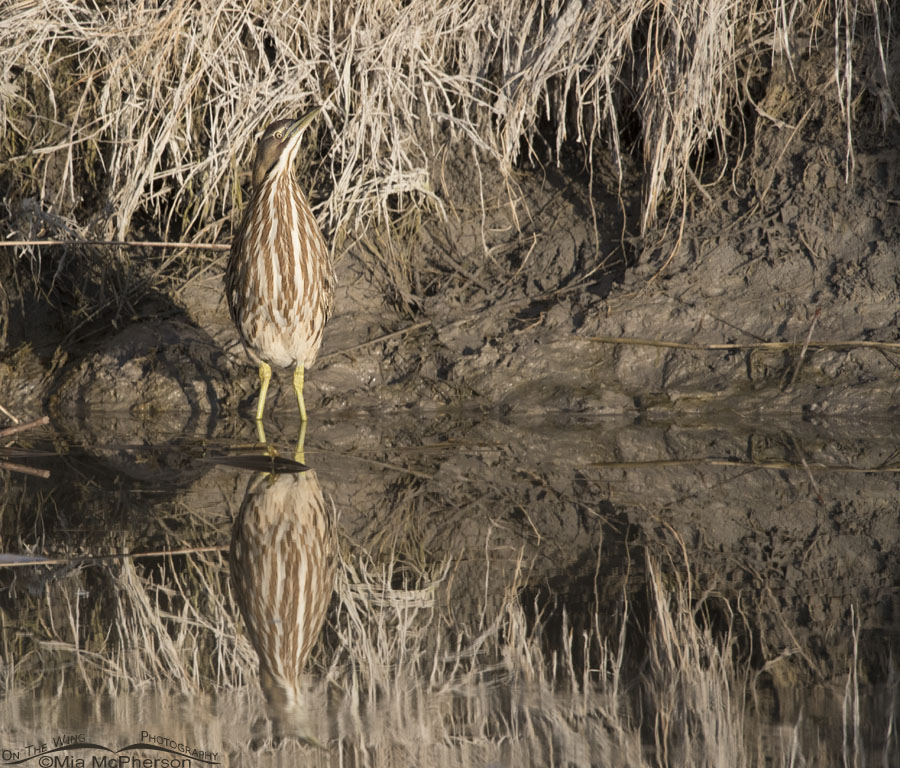 Documentary photo of American Bittern in flight – Nikon D500, f7.1, 1/4000, ISO 640, Nikkor 500mm VR with 1.4x TC, natural light
Documentary photo of American Bittern in flight – Nikon D500, f7.1, 1/4000, ISO 640, Nikkor 500mm VR with 1.4x TC, natural light
My best finds of the day yesterday morning were two American Bitterns on the riverbank of the Bear River at Bear River Migratory Bird Refuge, birds I do not normally see in January here in northern Utah. Both the bitterns blended in so well with the similarly colored vegetation on the bank of the river that they were hard for even me to see. When I spotted the first one I wasn’t quite sure it was a bittern so we backed up, I pointed the bitterns out, and I opened the window on the other side of the vehicle. I then used my camera and long lens to verify the identification of the bird. A hunter with an air boat rumbled past right about that time and before I could get outside to take a decent photo the bittern took off in flight, I swung my lens towards the bird and got some awful documentary shots.
But wow, an American Bittern in January is a pretty good sighting.
 Riverbank and hidden American Bittern – Nikon D500, f7.1, 1/2500, ISO 640, -0.7 EV, Nikkor 500mm VR with 1.4x TC, natural light
Riverbank and hidden American Bittern – Nikon D500, f7.1, 1/2500, ISO 640, -0.7 EV, Nikkor 500mm VR with 1.4x TC, natural light
Several hundred yards west I spotted the second, more well hidden American Bittern. Keep in mind this photo was taken using my 500mm with a 1.4x TC which gives me 700mm of effective focal length but with the crop factor on my D500 it is the equivalent of 1050mm of focal length. The bird looked so much like the vegetation on the riverbank to my naked eye that I almost didn’t see it but again I scoped it through the window just to make sure. I’m so glad I did.
 January American Bittern on the bank of the Bear River – Nikon D500, f7.1, 1/2000, ISO 640, -0.7 EV, Nikkor 500mm VR with 1.4x TC, natural light
January American Bittern on the bank of the Bear River – Nikon D500, f7.1, 1/2000, ISO 640, -0.7 EV, Nikkor 500mm VR with 1.4x TC, natural light
To my surprise the second American Bittern moved out into the open where I was able to take high quality images of it on the riverbank. Both of these bitterns may have been taking advantage of the warmth of the sun when I first saw them and pointed them out. Even out sunning itself on the riverbank it wasn’t that easy to see without the aid of my lens & camera.
I checked on eBird.org and there aren’t that many reports of American Bitterns in January, the majority of the sightings are at Fish Springs National Wildlife Refuge in Juab County, Utah, which is one of my favorite locations in Utah. American Bitterns are migratory and they will hang around if there is open water and because of our warmer than normal winter these bitterns may have stayed on at the refuge.
I was thrilled to spot not just one but two American Bitterns at Bear River Migratory Bird Refuge, they were truly unexpected and a delight to see and photograph.
Life is good.
Mia
Click here to see more of my American Bittern photos plus facts and information about this species.


To echo the sentiments of your other contributors…the ability of the bittern to blend into it’s habitat is nothing short of amazing! I am also one of those who marvels at your ability to spot subjects from significant distances. That’s pretty amazing too. Great shots Mia.
Eagle-eyes on display.
I would never have seen them, and am super impressed at their camoflague and that you spotted them.
A few years back I was told where I could find an American Bittern, but when I got there I saw nothing, and figured the bird had moved on – until I was shocked to realize it was right in front of me.
Matching Outfits!
Unbelievable camouflage!
Cool photos Mia
OMGosh……how well they blend in. I had to scroll back to see it. I heard a Bittern at a local stream last spring but never did see it. Frustrating.
I don’t call you “Eagle Eyes McPherson” for nothing! I had to look twice to see the Bittern in the second frame….great camoflage…great spotting….
I could not see the first one either. Beautiful and definitely high quality. Where I live the Great Blue Heron blends in very well with the weeds in waters The one pronounced characteristic that will readily distinguish them is their blue crested head. I have spent literally hours combing a river/swamp bank watching and waiting and then literally out of the blue, this very cautious bird will appear. I use my car as a blind.
This past week I was watching an American Bittern in rather thick spike-rush and it disappeared before my eyes! It had moved so slowly that I did not detect that it had retracted its neck and blended perfectly with the thick tangle of reeds close to the water.
Your ability to see these birds at such a distance is amazing to me. I had to move the picture and zoom in to distinguish the Bittern from the grasses. Their camouflage works extremely well.
It’s silhouette reminds me of some of the wadding birds we have in South Florida. A good day for you.
I couldn’t see the first one either! Had to scroll back. Nice birds any time of year. Good work.